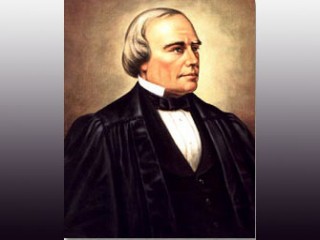
Benjamin Robbins Curtis biography
Date of birth : 1809-11-04
Date of death : 1874-09-15
Birthplace : Watertown, Massachusetts
Nationality : American
Category : Arhitecture and Engineering
Last modified : 2011-01-06
Credited as : Lawyer, U.S. Supreme Court member,
Benjamin Robbins Curtis was one of the most able lawyers on the U.S. Supreme Court in the 19th century.
Benjamin Robbins Curtis was born into an old New England family in Watertown, Mass., on Nov. 4, 1809. He graduated second in his class at Harvard in 1829, then took a degree from Harvard Law School. In 1833 he married Eliza Maria Woodward, with whom he had five children. When she died in 1844, he married again and had three more children.
Through the influence of a prominent uncle, Curtis became a partner in a Boston law firm in 1834, remaining until 1851 and becoming one of the leading commercial lawyers in the United States. He was elected to the Massachusetts General Court in 1849 and 1851 and was largely responsible for the Massachusetts Practice Act of 1851, which eliminated many legal abuses. When what was then the New England seat on the U.S. Supreme Court became vacant in 1851, President Millard Fillmore appointed Curtis.
In his first term Curtis's ability to cut to the heart of a problem led to establishing a commonsense interpretation of the commerce clause in Cooley v. Board of Wardens, which allowed states to regulate local commercial matters while not diminishing Congress's power. Another precedent-setting case enabled administrative officers to determine and collect debts without a court order. He was also highly effective in conference, "educating" by persuasion his fellow justices.
Riding the New England circuit, Curtis continued to show concern for law and order and preservation of the Union. Though labeled a "slave-catcher judge" because of his strict enforcement of the Fugitive Slave Act, he dissented on the precedent-setting Dred Scott case (1852) and wrote a long minority opinion demonstrating that African Americans were U.S. citizens in 1787, that residence in free territory made a man free, and that Congress had complete authority to legislate for the territories, including prohibiting slavery. Misunderstandings with Chief Justice Roger B. Taney over dissemination of these opinions were partly responsible for Curtis's resignation from the Court.
Returning to a lucrative private practice, Curtis argued several important cases before the U.S. Supreme Court. When his second wife died in 1860, he married again. He supported the North in the Civil War but raised important questions about presidential power in a pamphlet critical of Abraham Lincoln's Emancipation Proclamation and of suspension of the writ of habeas corpus. He opposed Lincoln's reelection in 1864. When President Andrew Johnson was impeached, Curtis and William M. Evarts defended him before the Senate.
In 1874 Curtis suffered a brain hemorrhage and died at Newport, R.I., on September 15. His course of lectures at Harvard for 1872-1873, Jurisdiction, Practice and Peculiar Jurisprudence of the Courts of the United States, was published in 1880.
There is no modern biography of Curtis. A eulogistic memoir by his brother and a volume of his writings edited by his son were published as A Memoir of Benjamin Robbins Curtis, L.L.D., with Some of His Professional and Miscellaneous Writings (2 vols., 1879; repr. 1969). Vincent C. Hopkins, Dred Scott's Case (1951), details Curtis's role in that case. His Court career appears in Leo Pfeffer, This Honorable Court: A History of the United States Supreme Court (1965).
















